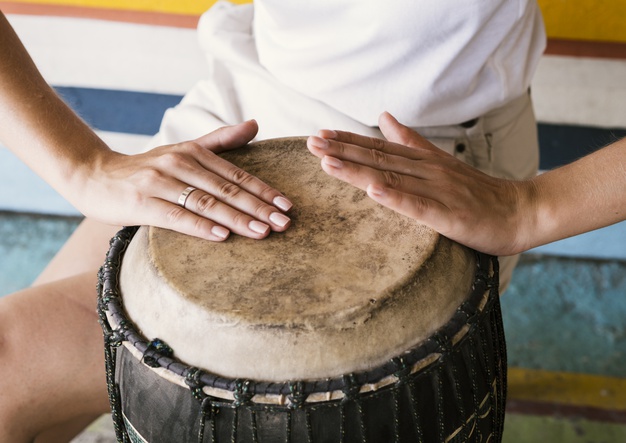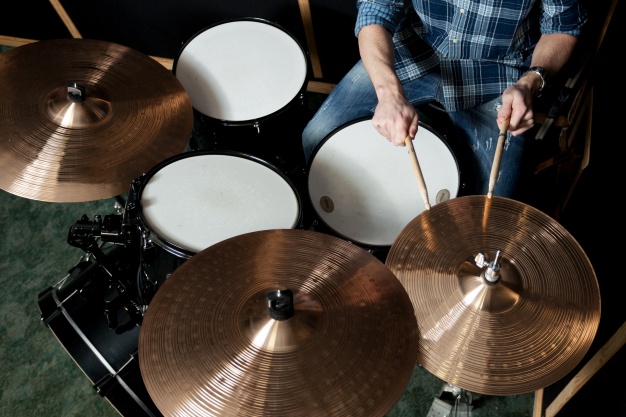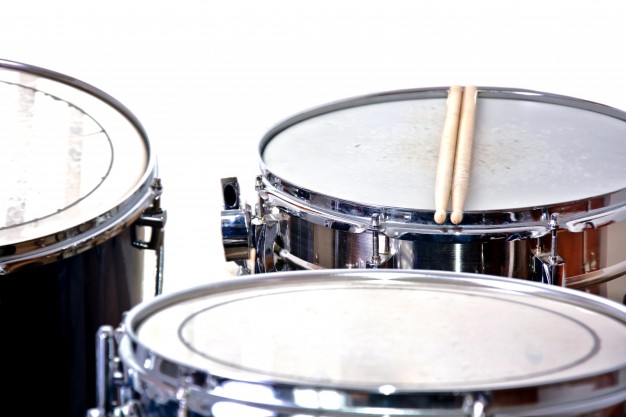
I was going through some comments on online music forums. There is this gentleman who says he has been teaching acoustic guitar to a high school kid.
He says the kid seemed to have been progressing well with his hands, except for the Rhythm. And he was bland enough to say the student had no rhythm.
In fact, understand even just the concept of Rhythm seems to be a huge problem. For this reason, he does not recognize tempo at all. Even clapping in synchronization with a metronome is not easy.
Many drummers have such difficulties. It may seem like something easy, but wait until you are faced with leading a real performance.
Even though a drummer plays from the background, they are important in keeping Rhythm and ensuring everyone gets the flow. Hence learning Rhythm is vital.
And this brings up the question, what is if any, the best way to exercise Rhythm that would help anyone improve?
In this guide, we are going to try and answer this question.
You are not alone

The first and most crucial step to learning rhythm is understanding that you are not alone. You may have seen pros use what they call an ‘internal sense of rhythm,’ which they use to keep a steady pulse. It feels as though they have a natural nose for a steady pulse.
May have reached a point where it feels as though they have an internal metronome in their heads. As such, you will not even see them tapping their feet or something.,
You should know that there is a difference between ‘rhythm’ and ‘timing.’ Rhythm is the regular succession of strong or weak beats. Timing, on the other hand, is all about and an individual being able to keep a beat themselves more so when they are in a group.
There are many musicians who cannot get the Rhythm and timing right. The main reason is mostly that they choose complicated music pieces that where they are in terms of experience.
I used to have the same issue, too, that made it hard for me to get the right steps. You need to keep in the three S’s of Rhythm; simple, slow, and steady.
Simple is all about the pieces you choose. You need to start with pieces that are not hard for any reason. Then slow means the tempo you should play the piece in. and steady is the Rhythm you are looking for.
Here are ten tips that will get you in the best rhythm foam;
1. Use a recorder
The best way to improve something is to know where you are. And in drumming, you can only get this if you record yourself. It is pretty easy, though.
First, you need to start simple. Pick a song that you are familiar with, perhaps your favorite play-along pieces. From here, choose a slow tempo.
Once you start playing, record your work from the beginning to the end. Don’t use a metronome first. It is always good to challenge yourself first, beyond what is obvious. You will get proper feedback on where you really fall.
Now sit back and list to the recording. Take note of your speed as per the tempo you chose. Are you following on well?
Try tapping or clapping alongside the recorded piece while keeping count of how many times you go it right.
Note that you will not always get right the first time. It took a very long time before I could get my Rhythm too. I wouldn’t be here if I got discouraged. So, don’t be losing it when you get the first time wrong.
2. Deliberate your practice
Now, don’t want to start something, and then give up along the way and leave it there. Research has shown that commitment to a routine creates a behavior.
And what you are looking to gain right now is a behavior that will not change. Hence, you want to make your practice a routine thing.
It is said that talented musicians don’t deliberately practice timing. They instead keep their mind on riffs, scales, and mini routines.
But before you get there, it would be a good idea to deliberate your practice. It just gives you a sense of focus and responsibility towards a goal.
3. Try new things where normal is not possible
Being a musician is all about tapping into your artistic mind. In other words, you are using your creativity to make your musicianship better.
And I have come to realize that musicians can impress others without even learning Rhythm. That may not be an excellent thing since making a good musician is so much more than just keeping a piece in your head and perhaps clock-timing.
In simple terms, a good musician must improvise. You don’t need just to do what is obvious.
Being the best has a lot to do with bringing out a more natural-sounding rhythm. If you learn to improvise in every performance, you will get the grasp of Rhythm much faster.
4. Simply tap and count
A lot of people know how to tap and count, even when they are not performing something musical. Now you can use this idea too.
Just identify one recording of your favorite song, and they clap your hands as you count. You will need to be very keen and listen to how the tap flow.
Tapping your leg may also be a nice way to follow Rhythm. Just start slowly but steadily. And once you are comfortable, you can add in counting. This depends on the time signature in which your music is.
You will discover that most music is in three or four beats time signature, simply try out both to identify one that is easier for you.
Taps that sound like waltz are probably three beats in every measure. And if it is like march, then that is probable a 4/4-time signature.
5. Learn to subdivide
Learning to count is only basic because you will be counting full tones. But there are faster beats that are half of what you may have learned.
Therefore learning to subdivide will help you grow faster.
Subdividing simply means splitting the beast of aa song into shorter beasts. If you have been playing music that is made up of quarter beats entirely, you may need to split and count 1/8 beast. So instead of counting one, two, three, four….., you can count one and, and three, and four…
This method is very important in learning faster beats. After all, you will not be playing slow songs all the time.
6. Learn from someone
The best drummers in the world began as apprentices. And you can do this too. There must be someone in your life who is a better musician already.
A friend, a neighbor, or a teacher, with a sense of music, maybe all you need to improve your skills. And I am very sure they will be more than happy to help you out.
Most people enjoy knowing that someone finds them admirable and wants to learn from them. This will be a good opportunity for you to find real criticism that will help you grow.
7. Make your senses conditioned
When it comes to becoming the best musician, you want everything you have to be invested in the music. Most of the best musicians have trained their minds to understand only what they want to know.
A pro, for instance, will easily tell when a snare gets a 1/64th late. It is just the way a mechanic knows when a metal cutter misses by a very insignificant size.
Awareness comes from experience. This means you need to train as hard as possible until your mind just sets that Rhythm itself. There is no other way but through consistency.
8. Get enough rest
The truth is, your mind and body will get tired much faster than anything else you may have done in your life. You don’t want to continue when that happens.
Whenever possible, take time to go and rest. When you come back, you will have a fresh mind to get that beat you missed. Resting lets you come up with even better ideas to learn more rhythm tricks.
9. Use a metronome
You may be wondering why I did not begin with this obvious option. The idea is that you get comfortable working on the Rhythm alone first, then you can grow from there.
Set your metronome right, first beginning with slow, steady beats with play-along songs. The most important thing however, is to build that feeling. You want the energy to settle in your mind and heart.
10. There is technology
There is a lot of technology in the world that can help you get your Rhythm right. For instance, most electronic drumheads come with built-in coaching features that train you on Rhythm. Make good use of such.
Conclusion

As you can see, Rhythm is something you just have to learn if you are a musician. There is no other way around it. I hope these tips help you get started.



